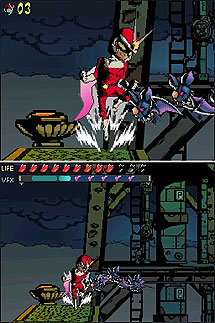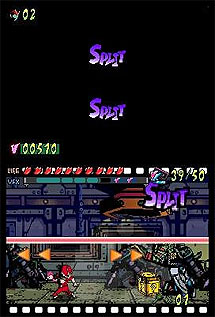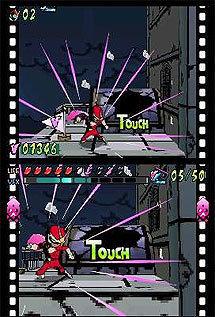
If you look through a film camera's viewfinder you'll see markers that form corners of a square. These markings indicate the boundaries of a 'safe action area', informing the camera operator that anything that reaches outside of those guides will not necessarily be seen by the viewing public, either because of the curvature of a television screen, projection cropping, or so on. These same guides appear in Viewtiful Joe: Double Trouble, Joe's first handheld outting, framing the on-screen action and lend Joe his 'viewtiful-ness', to bastardize an already nonsensical word. Outside of the fictional and fantastical Movieland, normal schmo Joe lacks any of his 'viewtiful' super powers, such as the ability to slow down (overcrank, for you cinephiles) or speed up (undercrank, or what they like to call 'Mach Speed') time, just like one would do in-camera. However, in Double Trouble Joe is up against an enemy that exists in the real world and can't depend on movie magic for powers. Enter the movie camera. Silvia (Joe's leading lady) steps to constantly have Joe in her viewfinder, recording him and his actions on film while also bestowing upon him his 'viewtiful' powers, but only as long as he's in the shot and in the safe action area.
When I noticed that these guides had been laid down for good ol' Joe, I was pleasantly surprised. I initially imagined that these limitations would open up numerous features and obstacles in the game, moments where perhaps Silvia would trip up and not be able to follow the action, leaving Joe to either stay 'viewtiful' within the safe area, or venture out of it to pummel his enemies without his powers. I thought it was a clever device, and immediately started trying to break out of the safe guides to see what repercussions might occur. Five minutes of desperate jumping and flaying about later, I realized it was a ruse, that the guides were mere fluff on the screen: You can't break out of the safe area, Silvia's camera-work is as sure and steady as a seasoned NFL photographer. A clever idea, wasted as decoration.

The same can be said for the bulk of Joe's new 'viewtiful' VFX attacks: they're great in concept, but the execution fails to live up to their potential. Now that Viewtiful Joe is on the DS, Capcom felt it was necessary to try and cram as many touch-screen oriented techniques as possible into the game. The prior 'Mach Speed' fixture has been replaced with a useless 'Scratch' power, allowing you to tap the screen and drop debris on your enemies. Joe can also 'Slide', a power that feebly utilizes the upper DS screen by requiring that you drag your finger from the top of the touch screen to the bottom, 'Slide'-ing the top screen with a close-up of the action down to the bottom screen - just as if your finger was an intermittent mechanism in a camera. 'Slide'-ing the screen like this replaces Joe's 'Zoom' power from the prior games, allowing you to activate some levers and hit enemies that you otherwise couldn't touch. Lastly, there's 'Split' which acts as if Joe spliced the bottom screen in two (akin to a film splice). Using Split, you can weasel your way into parts of the level that typically would be blocked off.
While the new effects are certainly clever ideas and while all relate reasonably well (if not slightly esoterically) to the mechancis of filmmaking, ultimately these powers hinder Viewtiful Joe's signature manic action. Requiring the player to repeatedly reposition their hands greatly breaks up the action and slows the game down, giving Double Trouble a lurching feeling. It doesn't help that there's little time to set a consistent beat to the game as you'll breeze through it in a handful of hours, even if you play at a leisurely pace. Double Trouble halts and stutters from beginning to end, sub-levels feel far too short, yet it feels like there are too many of them, that they only exist to pad out a meager game.

Additionally, none of the sub-levels have any feeling of intensity to them as they're collectively much easier than the prior games. With a substantial lack of extended waves of enemies to defeat, an overabundance of health items and save points and the amazingly short sub-levels, Double Trouble never infuses the player with the same sense of accomplishment as the previous titles. In fact, apart than a few puzzles requiring the use of the Split power, the game rarely presents any difficulty whatsoever. And it's not just the lack of any decent challenge that is frustrating, but the feeling that the game is stitched together discarded level designs plucked from brainstorming the prior games. Thematically the levels feels thrown-together, and that's not just because one sub-level is heavily modeled after Resident Evil. Other than Miniature World, none of the levels are terribly striking, and ultimately just feel like you're constantly retreading the same ground and fighting the same enemies. Sadly, this just causes the game to become more tiring than a game as extraordinarily short as Double Trouble should and exacerbates the padded feeling.
Like those ubiquitous safe lines, the game has some real ingenuity behind it. The Splice VFX attack had great potential, Slide has a smooth feeling to it that is uniquely tactile, and all are skillfully plucked from slightly more obscure filming mechanisms. Sadly, these elements feel wasted in this game, with the VFX-oriented puzzle sections repeatedly bring the game to a halt, and even when you finally achieve a good fighting groove, the sub-level abruptly ends. While the franchise has never been known for its depth, Double Trouble feels especially shallow, yet vapidly cluttered. It is over-decorated with features that Joe really could have done without and contains mechanics that do nothing but bog down the game. While the game stays true to the sharp visual style and cinematic flourishes the series is known for, the action and, more importantly the fun, is absent. The joy in Viewtiful Joe is in the frantic energy of combat, in juggling your VFX powers in combat and staying 'viewtiful', but Double Trouble falls flat when it comes to keeping the gamer enthused. With a better underlying structure, Double Trouble may have thrived, but instead it's cleverness is just wasted on this middling effort.




#1 D. Riley Dec 9, 2005 02:10pm
I'm pretty sure I'm the one who's supposed to be writing about VJ games!
All things considered, you have probably saved me another lackluster experience in my waning VJ love. :?
There's always (the predictably crappy) VJ fighting game!